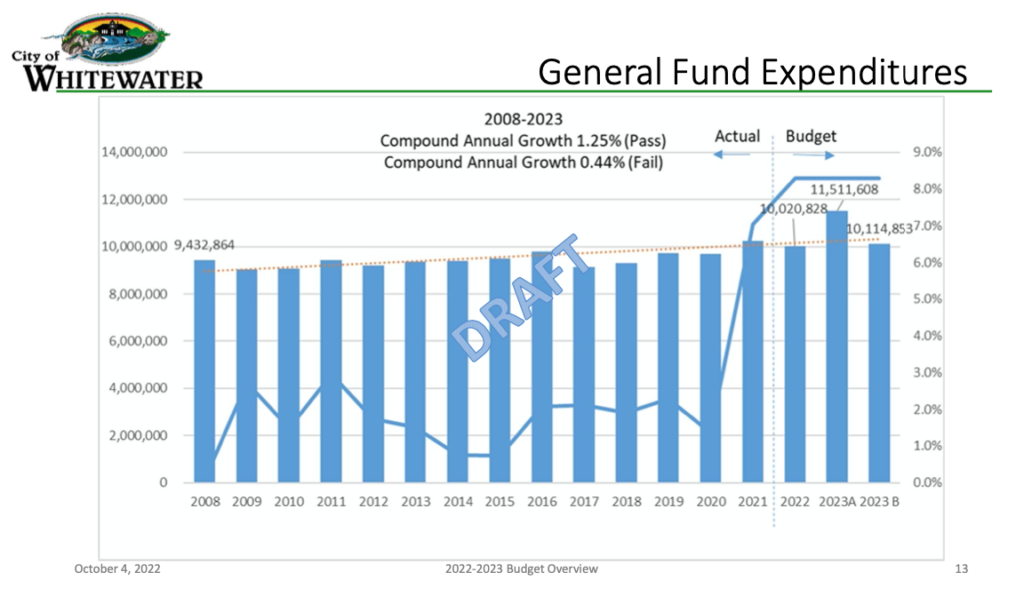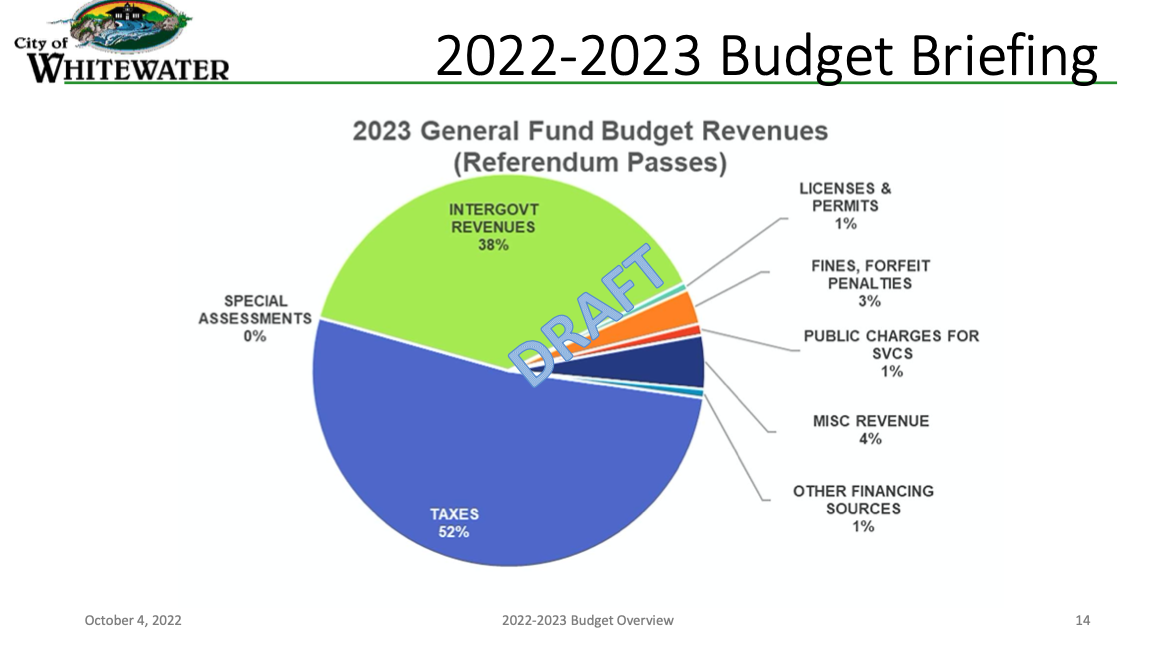Following is the first of a two-part series examining two budgets drafted for possible use in the city of Whitewater in 2023. In this, the first part, the budgets — one proposed for use if the city’s EMS referendum is approved in November by voters and one proposed for use if the referendum does not pass — are presented. Part two will explore how the two budgets will impact mill rates in both Walworth and Jefferson counties and changes those residents can expect to see on their tax bills.
By Kim McDarison
Whitewater Interim City Manager John Weidl and Director of Finance Steve Hatton Thursday provided Fort Atkinson Online with a “budget briefing,” explaining the development of two possible budgets, one of which likely will be placed in use next year.
A “presentation and brief overview of (a) draft 2023 budget and 2023 alternate budget” are among items listed on the Whitewater City Council’s Tuesday, Oct. 4 meeting agenda. The meeting will be held at the city’s municipal building, 312 W. Whitewater St., at 6:30 p.m. A virtual option for attendance also is available.
The two budget scenarios under development are contenders for use in the second year of the city’s biennial 2022-23 budget, which, according to city documentation, was adopted Nov. 16, 2021.
Weidl and Hatton noted Thursday that they have developed two budgets, one for use if the city’s proposed EMS referendum is approved by voters in November and one for use if it does not receive approval.
The EMS referendum question will appear before the city’s voters on the Nov. 8 ballot.
It reads as follows: “Under state law, the increase in the levy of the City of Whitewater for the tax to be imposed for the next fiscal year 2023 is limited to 7.673%, which results in a levy of $4,656,852. Shall the City of Whitewater be allowed to exceed this limit and increase the levy for the next fiscal year 2023 for the purpose of establishing, staffing and operating a City of Whitewater Municipal Government Fire and Emergency Services Department (Municipal Department), by a total of which results in a levy of $5,756,852, and on an ongoing basis, include the increase of for each fiscal year going forward?”
To fund the in-house department, the city is requesting an annual increase in the levy, which requires voter approval because it exceeds the state-imposed levy limit by $1.1 million, with those revenues used to fund the city’s newly acquired in-house fire department.
The city’s in-house fire department was formed in July through contractual agreement with Whitewater Fire Department, Inc., a volunteer paid-on-call fire and EMS department that, through an earlier contractual agreement, serviced the city and several neighboring communities. Whitewater Fire Department, Inc., while operating as a separate entity from the city, was housed in garage space attached to the city’s municipal building.
In bringing the department in-house, the city also has assumed ownership of contracts with neighboring communities formerly held by Whitewater Fire Department, Inc. Those communities include, in part or whole, the towns of Whitewater, Cold Spring, Koshkonong, Richmond, Lima and Johnstown.
In addition, the contractual agreement with the city bringing the department in house allowed for staffing changes: firefighters and EMTs have moved from a paid-on-call model to one in which they are paid members of the city’s staff. The change allows the department to increase the number of hours covered by staff, which, officials have said, would improve emergency crew response times.
An earlier story about the new fire department model and exploration of a November ballot referendum to fund the new department is here: https://fortatkinsononline.com/whitewater-council-approves-bringing-fire-department-in-house-explores-november-ballot-referendum/.
The two budgets
According to information supplied by city officials, in 2022, the city operated using a budget of $10,020,828, of which $3,217,219 was funded through the tax levy.
In 2023, the proposed budget, which was drafted before the fire department was brought in house, was $10,417,100. State statutes limit the budgetary obligation — known as the levy — which can be paid by the city’s taxpayers. In 2023 the levy limit is $4,656,852.
Among the recently amended budgets — both of which include the additional expenses associated with the in-house fire department — would voters approve the referendum, in 2023, the city anticipates operating with a budget of $11,511,608, funded, in part, with a tax levy of $5,756,852. Would taxpayers approve the referendum, the city would be able to exceed the levy limit by $1.1 million “going forward,” as language within the referendum question states, meaning in perpetuity, or as long as the city deemed it necessary.
Would voters decide against the referendum, in 2023, the city anticipates operating with a budget of $10,114,853, funded, in part, with a tax levy of $4,656,852, which is the initial levy limit as imposed by state statute.
Building a budget: Revenues and expenses
In a State of the City address delivered in October of 2021, then-City Manager Cameron Clapper offered a slide presentation noting revenue sources used to fund the city and the associated costs. In 2021, he said, the city developed its budget anticipating revenues of $9.6 million.

Referencing a slide (above) showing the city’s revenue sources, Clapper said during his presentation: “You can see property taxes and intergovernmental revenue make up the largest chunk of our dollars coming in, and intergovernmental revenues is actually more than property tax, so we are very dependent on the state for the dollars that they choose to allocate annually in the biannual budget to municipalities.”
Clapper said monies collected through the tax levy support 42% of the city’s operating budget and 47% come from intergovernmental revenues. Other sources, such as public charges for services, forfeitures, licenses and permits, special assessments and miscellaneous charges, each account individually for anywhere from 1% to 5% of the full general fund revenue pie.

Looking at general fund operating expenditures (above), Clapper said, public safety accounts for 40%; followed by general government expenses, at 16%; public works expenses and transfers, each coming in at 11%; debt service accounts for 10%; cultural, recreational and educational activities consume 8%, and conservation and development are allotted 4%.
Clapper defined expenditures associated with public works and public safety as “significant.”
“Public Safety, of course, is very expensive, with all of the equipment and training that’s required of our public servants,” he said.
A link to Clappers State of the City address from last year is here: https://fortatkinsononline.com/whitewater-city-manager-shares-state-of-the-city-address/.
Differences in the 2023 draft budgets
Within their presentation Thursday, Weidl and Hatton shared information showing the differences between the two draft budgets proposed in 2023.
Among guiding principles and goals, they noted a desire to deliver two balanced budgets, including one that could be used if the referendum passes and one which would be used if it does not, along with a desire to maintain a fund balance for the city equal or greater than 20% of the general fund operating budget.
Additionally, they offered a list of “notable items,” which — would voters approve the referendum in November — would allow for a budget that could: close the city’s share of the funding gap sustainably, maintain EMS personnel onsite with up to 17 full-time employees, and fully fund fire and EMS equipment replacement without debt. The fully funded budget, with the additional $1.1 million included, also would allow the city to more readily absorb the cost of inflation, calculated in August at 8.3% by Consumer Price Index for All Urban Consumers (CPI-U), and allow the city to maintain a 4% wage increase to retain staff.
Would the referendum fail, a second list, as presented by Weidl and Hatton, included notable items that would affect the city’s budgetary decisions. It included: an inability to close the city’s share of the funding gap sustainably; a reduction of fire and EMS staffing such that only one ambulance would be available to respond to calls 24/7, noting that the department currently runs two ambulances; a likelihood that debt would be required to replace fire and EMS equipment; a $28,000 increase in a solid waste and recycling fee which would be passed on to the consumer at an approximate cost of $15 per month; a need to maintain a vacant patrol officer position; deferrals of some revenue transfers that would traditionally be used for street maintenance and repair, and a reduction in the city’s electricity bill by making operational changes in some of the city’s street lights.
Additionally, the budget considers a reduction in funds transferred for the replacement of Department of Public Works equipment.
Both budgets look at the elimination of city-supplied flower baskets in the city’s downtown.
According to Weidl, with purchasing the baskets and supplying the manpower to sustain them, they cost the city annually approximately $16,000. While the item would be eliminated from the city’s budget, he said he believed there were other organizations within the city with the resources to take over the responsibility of the baskets.
Both budgets call for reductions in street maintenance and repair. Would the referendum pass, the fund would see a reduction of $26,000. Would the referendum fail, the fund would see a reduction of $37,000.
In a followup email, Hatton noted that the city’s normal level of funds transferred annually from the general fund to the city’s Fund 280 to pay for street repair and maintenance is $112,000. At the end of 2021, the fund had a balance of approximately $722,000. Planned projects in 2022 expended $232,000 and planned projects in 2023 will expend another $360,000.
“The original 2023 transfer to (Fund) 280 from the General Fund was $37,014 – short of the ‘normal/target’ $112,500 level due to the need to balance the original 2023 budget. As originally budgeted, the fund balance would dwindle to (approximately) $167,000. Even if the referendum passes, we’ll need to trim this (general fund) transfer further, below $37,000,” Hatton wrote.
Looking at the impact of the transfer reduction, he noted that the city’s Director of Public Works Brad Marquardt wrote in an email: “a mill or pulverize with an asphalt overlay runs about $80 per foot for a typical street width (28 feet of pavement).”
Hatton continued: “So, cost would translate into (approximately) $422,000 per mile. Said differently, a normal $112,500 funding level would refinish about .27 miles of street.”

A slide shared by city officials Thursday shows the predicted changes in the distribution of revenues would the referendum pass in November. When comparing the pie chart from 2021, 42% of revenues were derived from the tax levy. If the referendum is approved by voters in November, 52% of general fund revenues will derive from taxes.

A slide shared by city officials Thursday shows the trajectory of expenditures from 2008 to present, with both draft budgets for 2023 included.
Part 2 in this two-part series, examining tax impacts associated with funding the city’s in-house fire department, is here: https://fortatkinsononline.com/whitewater-tax-impacts-associated-with-funding-an-in-house-fire-department/.
This post has already been read 1813 times!
